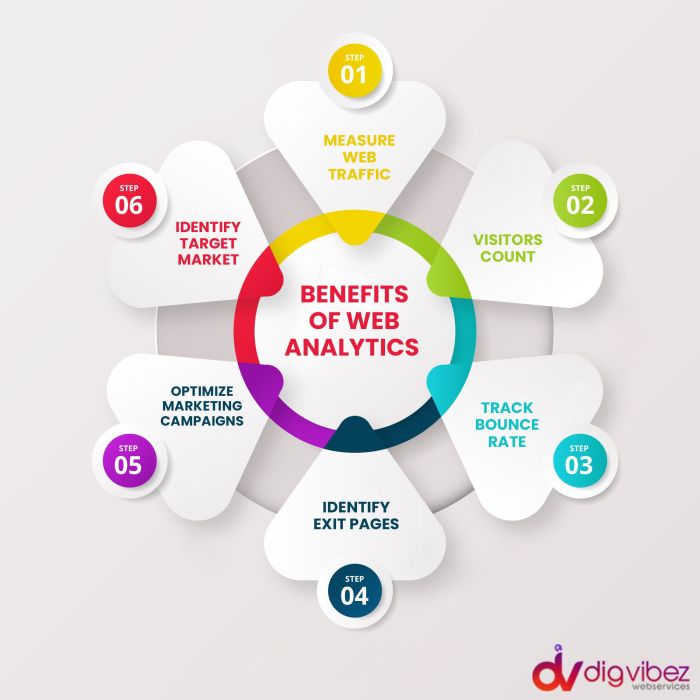Using Analytics in Marketing dives into the world of data-driven decision-making, offering businesses a competitive edge through strategic insights and measurable results. From understanding key metrics to implementing personalized campaigns, this topic explores the power of analytics in shaping successful marketing strategies.
As businesses navigate the digital landscape, harnessing the potential of analytics is crucial for maximizing ROI and staying ahead of the curve.
Introduction to Using Analytics in Marketing
Analytics plays a crucial role in modern marketing strategies, providing valuable insights that can help businesses make informed decisions and drive successful campaigns. By leveraging data and analytics tools, companies can optimize their marketing efforts, target the right audience, and ultimately improve their return on investment (ROI).
Importance of Analytics in Marketing, Using Analytics in Marketing
Analytics in marketing allows businesses to track, measure, and analyze various aspects of their marketing campaigns. By collecting and analyzing data, companies can gain a deeper understanding of customer behavior, preferences, and trends. This valuable information helps businesses tailor their marketing strategies to effectively reach their target audience and achieve their goals.
Key Metrics in Marketing Analytics
- Conversion Rate: Measures the percentage of website visitors who take a desired action, such as making a purchase or signing up for a newsletter.
- Customer Acquisition Cost (CAC): Calculates how much it costs to acquire a new customer, helping businesses evaluate the effectiveness of their marketing efforts.
- Customer Lifetime Value (CLV): Estimates the total revenue a customer is expected to generate over their lifetime, guiding businesses in determining how much to invest in acquiring and retaining customers.
Improving ROI with Analytics
Analytics can significantly impact the ROI of marketing campaigns by providing valuable insights into campaign performance and effectiveness. By analyzing data on key metrics, businesses can identify areas for improvement, optimize their strategies, and allocate resources more efficiently. This data-driven approach helps businesses maximize their ROI and achieve better results from their marketing efforts.
Types of Marketing Analytics
Marketing analytics play a crucial role in helping businesses make informed decisions and optimize their marketing strategies. There are four main types of marketing analytics: descriptive, diagnostic, predictive, and prescriptive.
Descriptive Analytics
Descriptive analytics focus on summarizing past data to provide insights into what has happened in a marketing campaign. This type of analytics helps marketers understand trends, patterns, and key performance indicators (KPIs) from historical data.
Diagnostic Analytics
Diagnostic analytics delve deeper into the data to identify the reasons behind certain outcomes. Marketers use diagnostic analytics to pinpoint the factors that lead to specific results, such as high conversion rates or low engagement.
Predictive Analytics
Predictive analytics leverages historical data and statistical algorithms to forecast future trends and outcomes. Marketers use predictive analytics to anticipate customer behavior, optimize marketing campaigns, and make data-driven decisions.
Prescriptive Analytics
Prescriptive analytics goes a step further by recommending actions based on predictive insights. Marketers can use prescriptive analytics to determine the best course of action to achieve desired outcomes, such as increasing sales or improving customer retention.
Real-time Analytics in Marketing Strategies
Real-time analytics enable marketers to monitor and analyze data as it is generated, allowing for immediate adjustments to campaigns based on real-time insights. This agile approach helps businesses respond quickly to changing market conditions and customer preferences.
Tools and Platforms for Marketing Analytics
There are various tools and platforms available to assist marketers in implementing different types of analytics. Examples include Google Analytics for web analytics, HubSpot for inbound marketing analytics, and Tableau for data visualization and reporting.
Implementing Marketing Analytics: Using Analytics In Marketing

Implementing marketing analytics is crucial for businesses looking to make data-driven decisions and optimize their marketing strategies. By leveraging analytics tools, companies can gain valuable insights into customer behavior, campaign performance, and overall ROI. Here are some key steps to set up a marketing analytics strategy:
Setting Up a Marketing Analytics Strategy
- Define goals and objectives: Clearly Artikel what you want to achieve with your marketing analytics efforts. Whether it’s improving conversion rates, increasing customer retention, or optimizing ad spend, having specific goals will guide your strategy.
- Choose the right analytics tools: Select tools that align with your goals and budget. Popular options include Google Analytics, Adobe Analytics, and HubSpot.
- Collect relevant data: Ensure you’re capturing data that is meaningful and actionable. This may include website traffic, social media engagement, email open rates, and more.
- Analyze and interpret data: Use analytics tools to analyze the data and draw insights. Look for trends, patterns, and correlations that can inform your marketing decisions.
- Take action based on insights: Implement changes to your marketing strategy based on the insights gained from your analytics. This could involve tweaking campaigns, targeting specific audience segments, or adjusting messaging.
Importance of Data Quality and Data Governance
Data quality and governance are essential components of successful analytics implementation. Without clean, accurate data, your analytics results may be skewed or unreliable. It’s important to establish data governance practices to ensure data consistency, integrity, and security. This includes setting up data validation processes, defining data ownership, and implementing data quality controls.
Integrating Analytics into Various Marketing Channels
- Website analytics: Track visitor behavior, conversion rates, and engagement metrics on your website to optimize user experience and drive conversions.
- Social media analytics: Monitor social media performance, audience demographics, and engagement metrics to refine your social media strategy and content.
- Email marketing analytics: Analyze email open rates, click-through rates, and conversion rates to improve email campaigns and personalize messaging.
- Advertising analytics: Measure ad performance, ROI, and audience targeting to optimize ad spend and maximize results.
Leveraging Analytics to Personalize Marketing Efforts
- Segment your audience: Use analytics data to segment your audience based on demographics, behavior, and preferences. This allows you to deliver personalized content and offers to different customer segments.
- Create targeted campaigns: Develop targeted marketing campaigns based on analytics insights to reach specific audience segments with relevant messaging and offers.
- A/B testing: Use analytics to conduct A/B tests and optimize campaign elements such as subject lines, ad copy, and calls-to-action for better performance.
- Dynamic content: Personalize website content, email messages, and ads based on user behavior and preferences to enhance engagement and drive conversions.
Benefits of Using Analytics in Marketing

Analytics play a crucial role in modern marketing strategies, offering a wide array of benefits that can significantly impact a company’s success. By leveraging analytics, businesses can make more informed decisions, improve customer experiences, and optimize their marketing efforts for better results.
Enhanced Customer Segmentation
Analytics allows marketers to segment their customer base more effectively by analyzing data such as demographics, behavior, and preferences. This segmentation enables personalized marketing campaigns tailored to specific customer groups, resulting in higher engagement and conversion rates.
Improved Customer Engagement
Analytics helps marketers understand customer behavior across various channels, enabling them to create targeted and relevant content that resonates with their audience. By analyzing engagement metrics, businesses can refine their strategies to enhance customer interactions and build stronger relationships.
Optimized Marketing Budgets
Through analytics, marketers can track the performance of their campaigns in real-time, allowing them to allocate resources more efficiently. By identifying which channels and tactics yield the best results, businesses can optimize their marketing budgets and maximize ROI.
Measuring Marketing Campaign Performance
Analytics provides valuable insights into the effectiveness of marketing campaigns, allowing businesses to monitor key performance indicators and adjust their strategies accordingly. By tracking metrics such as conversion rates, click-through rates, and customer acquisition costs, marketers can evaluate the success of their campaigns and make data-driven decisions for future initiatives.
